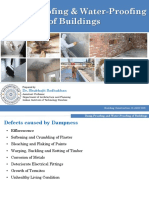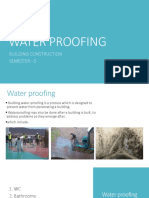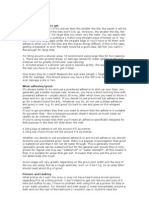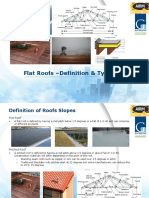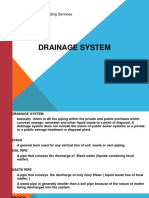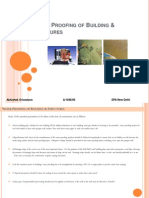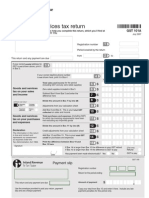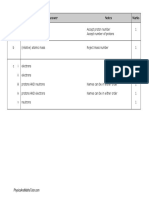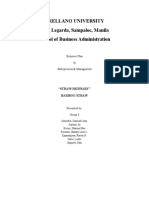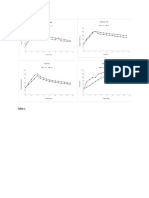Waterproofing 001
Waterproofing 001
Uploaded by
Clyde D'cruzCopyright:
Available Formats
Waterproofing 001
Waterproofing 001
Uploaded by
Clyde D'cruzCopyright
Available Formats
Share this document
Did you find this document useful?
Is this content inappropriate?
Copyright:
Available Formats
Waterproofing 001
Waterproofing 001
Uploaded by
Clyde D'cruzCopyright:
Available Formats
WATER-PROOFING / DAMP-PROOFING
One of the basic requirements in case of all the buildings is that the structure should remain dry as far as possible. If this condition is not satisfied , it is likely that the building may become inhabitable and unsafe from structure point of view. Hence in order to prevent the entry of dampness into a building , the course known as DAMP PROOF COURSE is provided at various levels of entry of dampness into a building. At present , practically all the buildings are given the treatment of Damp proofing. Thus , the provision of Damp proofing courses prevents the entry of moisture through walls , floors and basements of a building. The treatment given to the roofs of a building for the same purpose is known as WATER PROOFING.
MEANING OF THE TERM DAMP-PROOFING
PROBLEM
SOLUTION
The dampness in a building is a universal problem and the various causes which are responsible for the entry of dampness in a structure are as follows:RISE OF MOISTURE FROM THE GROUND:The ground on which the building is constructed may be made of soils which easily allow the water to pass. Usually the building materials used for the foundations, absorb moisture by capillary action. Thus the dampness finds its way to the floors through the substructure. ACTION OF RAIN:If the faces of wall, exposed to heavy showers of rain, are not suitably protected, they become the sources of entry of dampness in a structure. Similarly the leaking roofs also permit the rain water to enter a structure. EXPOSED TOPS OF WALLS:The parapet walls and compound walls should be provided with a damp-proof course on their exposed tops. Otherwise the dampness entering through these exposed tops of such walls may lead to serious results.
CAUSES OF DAMPNESS
CONDENSATION:The process of condensation takes place when warm humid air is cooled. This is due to the fact that cool air can contain less invisible water vapour than warm air. The moisture is deposited on the walls, floors and ceilings. This is the main source causing dampness in badly designed kitchens. MISCELLANEOUS:There are various miscellaneous causes of dampness as mentioned below: (i) If the structure is located on a site which cannot be easily drained off, the dampness will enter the structure. (ii) The orientation of a building is also an important factor. The walls obtaining less sunshine and heavy showers of rain are liable to become damp. (iii) The newly constructed walls remain damp for a short duration. (iv) Very flat slope of a roof may also lead to the penetration of rain water which is temporarily stored on the roof. (v) The dampness is also caused due to bad workmanship in construction such as defective rain water pipe connections, defective joints in the roofs, improper connections of walls, etc.
CAUSES OF DAMPNESS
Thus the important sources of dampness can be summarized as follows: (1) defective junctions between roof slab and parapet wall; (2) defective roof covering of the pitched roofs;
(3) faulty eaves and valley gutters;
(4) improper rain water pipe connections; (5) inadequate roof slope; (6) moisture from wet ground below foundation; (7) splashing rain water; (8) unprotected tops of walls, parapets and compound walls; etc.
CAUSES OF DAMPNESS
The building materials such as bricks, timber, concrete, etc., have a moisture content which is not harmful under normal circumstances. The rise in moisture content of these materials beyond a certain level from where it becomes visible or when it causes deterioration leads to the real dampness. In absolute terms, the moisture content of different materials may be the same. But the acceptable limit differs from material to material. For instance, the presence of 10 per cent by weight of water in timber is not harmful. But the same level could saturate a brick or cause deterioration of plaster.
EFFECTS OF DAMPNESS
The structure is badly affected by dampness. The prominent effects of dampness are as follows: (1) A damp building gives rise to breeding of mosquitoes and creates unhealthy conditions for those who occupy it. (2) The metals used in the construction, of the building are corroded. (3) The unsightly patches are formed on the wall surfaces and ceilings. (4) The decay of timber takes place rapidly due to dry-rot in a damp atmosphere. (5) The electrical fittings are deteriorated and it may lead to leakage of electricity and consequent danger of short circuiting. (6) The materials used as floor coverings are seriously damaged. (7) It promotes and accelerates the growth of termites. (8) It results in softening and crumbling of the plaster. (9) The materials used for wall decoration are damaged and it leads to difficult and costly repairs.
EFFECTS OF DAMPNESS
(10) The continuous presence of moisture in the walls may cause efflorescence which may result in disintegration of stones, bricks, tiles, etc. and the strength of wall is then reduced, (1 1) The floorings get loosened because of reduction in the adhesion when moisture enters through the floor. (12) The dampness combined with warmth and darkness breeds germs of dangerous diseases such as tuberculosis, rheumatism, etc., and the occupants may also become asthmatic.
EFFECTS OF DAMPNESS
Following are the requirements of an ideal material for the damp-proofing: (1) The material should be durable. As a matter of fact, the damp-proof course should remain effective during the useful life of the building. (2) The material should be such that it remains steady and does not allow any movement in itself. (3) The material should be perfectly impervious. (4) The material should be capable of resisting safely the loads coming on it. (5) The material should be flexible so that it is capable of accommodating the structural movements without any fracture. (6) The material should be dimensionally stable.
(7) The material should be reasonably cheap.
REQUIREMENTS OF AN IDEAL MATERIAL FOR DAMP PROOFING
(8) The material should be such that it is possible to carry out leak-proof jointing work. (9) The material should be free from deliquescent salts like sulphates. chlorides and nitrates.
REQUIREMENTS OF AN IDEAL MATERIAL FOR DAMP PROOFING
Following are the materials which are commonly used for damp-proofing: (1) Hot bitumen: This is a flexible material and is placed on the bedding of concrete or mortar. This material should be applied with a minimum thickness of 3 mm. (2) Mastic asphalt: This is a semi-rigid material and it forms an excellent impervious layer for damp-proofing. The good asphalt is a very durable and completely impervious material. It can withstand only very slight distortion. It is liable to squeeze out in very hot climates or under very heavy pressure. It should be laid by experienced men of the specialist firms. (3) Bituminous felts: This is a flexible material. It is easy to lay and is available in rolls of normal wall width. It is laid on a layer of cement mortar. An overlap of 100 mm is provided at the joints and full overlap is provided at all corners. The laps may be sealed with bitumen, if necessary. The bitumen felt can accommodate slight movements. But it is liable to squeeze out under heavy pressure and it offers little resistance to sliding. The material is available in rolls and it should be carefully unrolled, especially in cold weather.
MATERIALS USED FOR DAMP PROOFING
(4) Metal sheets: The sheets of lead, copper and aluminium can be used as the membranes of damp-proofing. The lead is a flexible material. The thickness of lead sheets should be such that its weight is not less than 200 N/m2 . The lead can be dressed to complex shapes without fracture and it possesses high resistance to sliding action. It is impervious to moisture and it does not squeeze out under ordinary pressure. It resists ordinary atmospheric corrosion. The surfaces of lead coming in contact with lime and cement are likely to be corroded and hence the metal should be protected by a coating of bitumen or of bitumen paint of high consistency. The copper is a flexible material. It possesses higher tensile strength than that of lead. It is impervious to moisture and it does not squeeze out under ordinary pressure. It possesses high resistance to sliding action. The external walls, especially of stones, are likely to be stained when a damp-proof course of copper is adopted. The surfaces of copper coming in contact with mortars are likely to be affected. But, for normal use, the metal does not require any protective coating.
The aluminum sheets can also be used for damp-proofing. But they should be protected with a layer of bitumen.
MATERIALS USED FOR DAMP PROOFING
(5) Combination of sheets and felts: A lead foil is sandwiched between asphalt or bituminous felt. This is known as the lead core and it is found to be economical, durable and efficient. (6) Stones: The two courses of sound and dense stones such as granites, slates, etc. laid in cement mortar with vertical breaking joints can work as an effective damp-proofing course. The stones should extend for full width of the wall. Sometimes the stones can be fixed, as in case of roof surfaces, on the exposed faces of the wall, etc. (7) Bricks: The dense bricks, absorbing water less than 4.50 % of their weight, can be used for damp-proofing at places where the damp is not excessive. The joints are kept Open. Such bricks are widely used when a damp-proofing course is to be inserted in an existing wall. (8) Mortar: The mortar to be used for bedding layers can be prepared by mixing 1 part of cement and 3 parts of sand by volume. A small quantity of lime is added to increase the workability. For plastering work, the water-proof mortar can be prepared. It is prepared by mixing 1 part of cement, 2 parts of sand and pulverized alum at the rate of 120 N per m3 of sand. In the water to be used, 0.75 N of soft soap is dissolved per litre of water and this soap water is then added to the dry mix. The mortar thus prepared is used to plaster the surfaces. Alternatively some patented water-proofing material such as Pudlo, Cido, Dempro, etc. may be added to the cement mortar.
MATERIALS USED FOR DAMP PROOFING
(9) Cement concrete: A cement concrete layer in the proportion 1 :2:4 is generally provided at the plinth level to work as a damp proofing course. The depth of cement concrete layer varies from 40 mm to 150 mm. It stops the rise of water by capillary action and it is found to be effective at places where the damp is not excessive. (10) Plastic sheets: The material is made of black polythene having thickness of about 0.50 mm to 1 mm with usual width of wall and it is available in roll lengths of 30 m. This treatment is relatively cheap but it is not permanent.
MATERIALS USED FOR DAMP PROOFING
It should be remembered that when a damp-proof course is found to be ineffective, the fault usually lies in its position or location rather than the defects in the material: The general principles to be observed in case of all the damp-proofing methods are as follows: (1) The' damp-proofing course may be horizontal or vertical. (2) The horizontal damp-proofing course should cover the full thickness of the wall excluding rendering. (3) At junctions and corners of a wall, the horizontal damp proofing course should be laid continuous. (4) The mortar bed which is prepared to receive the horizontal damp-proofing course should be even and levelled and free from projections so that the damp-proofing course is not damaged. .
(5) The damp-proofing courses should be laid so as to make a continuous protection.
GENERAL PRINCIPLES OF DAMP PROOFING
(6) The damp-proofing course should not be kept exposed on the wall surface. Otherwise it is likely to be damaged by carpenters tile layers, etc. during the finishing work. (7) When a horizontal damp-proofing course i.e. that of a floor is continued to a vertical face, a cement concrete fillet of about 75 mm radius should be provided at the junction.
GENERAL PRINCIPLES OF DAMP PROOFING
There are various methods of damp-proofing and depending upon the nature of surface, situation of the structure and amount of dampness, the proper method is selected. Following are the methods or measures adopted to prevent entry of dampness:
METHODS OF DAMP PROOFING
( 1) It the level of the ground floor is in level with the ground surface or just above it, the damp-proofing course is provided as shown in fig. 6-1. The material should be flexible and it should be stepped vertically through the wall to meet the damp-proofing course of the solid floor.
METHODS OF DAMP PROOFING
(2) If two ground floors at different levels are connected by an internal wall, the dampproofing course may be provided as shown in fig. 6-2. It should be noted that the dampproofing course on the internal wall is in level with the lower floor level.
METHODS OF DAMP PROOFING
(3) In order to prevent the rising of moisture from the adjacent ground, the air drains may be provided as shown in Fig. 6-3. An air drain is a narrow hollow space which is constructed parallel to the external wall. The width of air drain is about 200 mm to 300 mm. The openings with gratings are provided at regular Intervals for the passage of air. The wall forming the air drain rests on the foundation concrete of the main wall and is carried about 150 mm above the ground level. The top of air drain is covered either by an R.C.C Slab or a stone and necessary arrangements are provided for the inspection of the air drain. The vertical and horizontal damp-proofing course are provided as shown in fig. 6-3.
METHODS OF DAMP PROOFING
(4) In case of basements, the damp-proofing course should be properly provided. Otherwise the basements' become useless except for the storage of materials unaffected by dampness. The usual practice is to provide asphalt tanking as shown in fig. 6-4.
METHODS OF DAMP PROOFING
The important facts to be observed in case of asphalt tanking are as follows: (i) The layer of asphalt should be continuous. (ii) The vertical end of asphalt layer may end in a horizontal damp-proofing course, if necessary.
(iii) The vertical damp-proofing course should be taken above ground level for a minimum distance of 150 mm.
(iv) The sequence of construction should be: inner wall, asphalt layer and protective wall. The reverse sequence may also be adopted but with less success. (v) The thickness of horizontal asphalt layer at basement floor level is 30 mm and it is laid in three coats. The thickness of vertical asphalt layer is 20 mm and ,it is laid in three coats.
METHODS OF DAMP PROOFING
The treatment of asphalt tanking is adopted when the subsoil water table is not very high. It is possible that the vertical D.P.C., if not properly protected, is likely to get punctured by roots of trees or damaged by salts or acids in the soil. The outer one-half rick protective wall is constructed to grant protection from such damage to the D.P.C. A protective flooring of flat bricks is provided on the foundation concrete to protect the D.P.C. from damage during the construction of floor slab. (5) The rain water gutters, in case of pitched roofs. may be constructed in cement concrete and standard rain water fittings may be used. Further the gutters may be, lined with bituminous materials or burnt clay products. (6) The cement paints, when applied suitably, act as effective vertical damp-proofing courses. (7) For cheaply constructed buildings, the damp-proofing course may be provided in the form of a layer of well burnt bricks which are dipped in hot tar and pitch.
(8) In case of a sloping ground, the damp-proofing course should be stepped such that it remains at a minimum vertical distance of 150 mm above ground as shown in fig. 6-5. The damp-proofing course may be of any suitable flexible material such as bituminous felt, etc.
METHODS OF DAMP PROOFING
METHODS OF DAMP PROOFING
(9) The construction of cavity walls considerably prevents the entry of damp inside the building. Suitable damp-proofing courses may be provided on these walls. (10) The provision of coping on a wall prevents considerably the entry of damp from the top surface of the wall. ( 1 1) The good workmanship and use of materials of better quality on face of the walls immensely help in preventing the entry of dampness inside the building. (12) For providing damp-proof course in an existing wall, the following procedure is adopted: (i) The level at which the damp-proof course is to be provided is carefully decided after considering the ground level and the floor level. It is usually kept about 150 mm above the ground level or floor level, whichever is higher. (ii) A special saw made of steel blades is used to make a cut at the corner of the wall. (iii) The loose bricks from the course just above the cut are carefully removed. (iv) The damp-proof membrane, usually bituminous felt, is inserted immediately after the cut is made.
METHODS OF DAMP PROOFING
(v) The cycle of cutting the slot and inserting the damp proof membrane is repeated till the entire length of wall is completed. (vi) The removed bricks are re-laid and the surface is finished with plaster or pointing. The above method of providing damp-proof course in an existing wall proves to be speedy, easy and economical. After the layer is laid, the height of exposed wall between the damp-proof layer and floor or ground level should be treated with suitable paint.
METHODS OF DAMP PROOFING
MEANING OF THE TERM The term water leakage in the buildings means the coming out of water from components like walls and floors of the buildings. It is observed that in the building industry that 99% of water leakage problems are concentrated on the terrace roofs and in the toilets. The water leakage in the buildings is the most common problem particularly in all types of buildings such as residential flats , hospitals , offices , school buildings , etc.,
WATER LEAKAGE
It is necessary to prevent water leakage in the buildings so as to provide healthy and happy environment. It will also avoid damages to household articles, costly painting and short circuiting of electrical Wiring. The defects which cause water leakages in the buildings can be grouped in the following three categories: ( 1) Defects due to poor maintenance (2) Defects in construction (3) Defects in design.
REASONS AND PREVENTIVE MEASURES FOR WATER LEAKAGE
(1) DEFECTS DUE TO POOR MAINTENANCE: The neglected maintenance along with weathering and aging leads to the water leakage in the existing buildings. The flowing water is dynamic and rushes through valves, traps, washers, taps and cocks situated at several places in the building. These things are subjected to constant wear and tear. They therefore require periodical maintenance. As such, non-repairing attitude proves detrimental to the safety of the structure. Following are the measures to be taken to minimize water leakage due to poor maintenance: (i) Filling of joints: The joints in the drainage system should be filled with rich cement mortar. Due to aging, the strength of cement mortar deteriorates resulting in leakages through the cracked joints. The remedy lies in filling such joints, initially with epoxy mortar or at least at a later stage while repairing the same. (ii) Improper use of toilets: It is necessary to educate the public for properly using the toilet system. For instance, in the drainage system of public hospitals, it is observed that the patients and their near relatives misuse the toilet systems by throwing bandages, cotton waste, injection bottles, etc. It ultimately leads to the choking of the drainage system.
REASONS AND PREVENTIVE MEASURES FOR WATER LEAKAGE
(iii) Joints in floor of toilets: The joints in tiles of bath and water closet are filled with white cement. These joints get loose after continuous use and require periodical maintenance and sealing with white cement. (iv) Replacement of taps: The leaking water taps lead to colossal waste of filtered water and avoidable water leakages in the building. It is therefore necessary to provide good quality bibcocks initially and go on replacing washers periodically, whether required or not, as a preventive maintenance measure.
REASONS AND PREVENTIVE MEASURES FOR WATER LEAKAGE
(2) DEFECTS IN CONSTRUCTION: The defects at the construction stage include honeycombing in concrete, use of defective materials, bad workmanship, etc. The remedial measures to avoid water leakage due to such defects are as follows: (i) Defective concrete: The provision of well designed compacted dense concrete with proper curing can solve number of leakage problems in a building. (ii) Door frame joint near toilet: The joint between door frame and flooring of bath and water closet should be made leak proof :y applying epoxy mortar or cement slurry. (iii) Plumbing: The joints in the plumbing of w.c. seats and nahni traps should be filled with rich cement mortar and cured for seven days. If curing is not properly done, the rich cement mortar gets cracked and leads to leakage. If possible, one piece P trap should be used to reduce one joint in the drainage system and it should be fixed before waterproofing of the w.c. block is started. (iv) Push cocks: The concussive or violently shaking type push cocks fitted for the flushing of w.c. pans lead to vibration and consequently the joints in the drainage system get dislodged and lose watertightness. It is therefore desirable to provide wheel valves or other suitable valves which do not cause vibrations.
REASONS AND PREVENTIVE MEASURES FOR WATER LEAKAGE
(v) Rain water spouts: The improper fixing of the rain water spouts in the roof slabs leads to leakage. For instance, if the rain water spout is fixed at higher level, the water stagnates' and the leakage starts. (vi) Sill to terrace door: If the terrace door is not provided with, sill, the water will find entry in the staircase through the door. (vii) Water-proofing of terrace: To prevent leakage from the roof, the terrace should be given proper water-proofing treatment. The joint between terrace slab and parapet wall should be properly finished to avoid leakages.
REASONS AND PREVENTIVE MEASURES FOR WATER LEAKAGE
(3) DEFECTS IN DESIGN: The defects in planning and design can be avoided in the preconstruction stage by entrusting the work to experienced and well trained architect and engineer. Some of the measures to avoid water leakage due to faulty planning are as follows: (i) Design of floor slab: It should be seen that the design of floor slab and centering should be such that the local stagnation of water does not occur. (ii) Design of rain water spouts: The rain water spouts of less; than 100 mm diameter should not be used. It is also desirable to provide one spout for every 40 m2 area of terrace.
(iii) Fixing of nahni traps: The nahni traps are required for toilets, kitchen sinks, washbasins, etc. The niche or pocket of clear size about 300 mm x 300 mm x 150 mm should be provided to accommodate the nahni traps and their locations should be clearly shown in the plan.
REASONS AND PREVENTIVE MEASURES FOR WATER LEAKAGE
(iv) Location of sanitary block: For public buildings like schools, hospitals, hostels, colleges, commercial centres, theatres, etc., it is desirable to detach the sanitary block in the planning stage only. Such a criteria will help in keeping the building usable even if the sanitary block suffers from leakage. It will also avoid the spreading of dampness in the rest of the building. The entire sanitary block should be sunk to a sufficient depth to accommodate the items of sanitation. As a matter of fact, the engineer should supply a detailed plumbing drawing of the sanitary block showing the slope of pipes, slope of gutters carrying urinal effluent, washbasin effluent, general slope of the toilet flooring, etc. (v) Relief valves: It is necessary to provide break pressure relief valves at suitable vertical distance in multistoried buildings to prevent seepage of water through the plumbing system. (vi) Slope of terrace slab: The minimum slope of 1 in 100 to 1 in 60 should be clearly shown on the terrace plan. It will help in adjusting the slope in centering with uniform thickness of roof slab. The suitable provision of terrace slope would result in smooth disposal of rainwater.
REASONS AND PREVENTIVE MEASURES FOR WATER LEAKAGE
(vii) Water tanks: For overhead R.C.C. water storage tanks, it should be seen that the permissible limits of stresses relating to resistance to cracking are not exceeded. The detailed bar bending schedule should be supplied by the designer. The bottom slab of overhead water tank should be placed one metre above the roof slab. It will facilitate proper centering during construction and also for locating and repairing the leakages after construction.
REASONS AND PREVENTIVE MEASURES FOR WATER LEAKAGE
You might also like
- Building Construction-Damp-proofing and Water-ProofingDocument41 pagesBuilding Construction-Damp-proofing and Water-ProofingsagarNo ratings yet
- PSW TemplateDocument1 pagePSW Templateramz37100% (1)
- Damp Prevention BuildingDocument14 pagesDamp Prevention BuildingTarekegnNo ratings yet
- Damp ProofingDocument18 pagesDamp Proofingchristelle do100% (2)
- Damp ProofingDocument30 pagesDamp Proofingमन्दिप नेपालNo ratings yet
- Building DefcetsDocument13 pagesBuilding Defcetsvartika100% (1)
- Water ProofingDocument20 pagesWater ProofingShashwat Jain100% (1)
- Tiling BibleDocument8 pagesTiling BibleAdrian FavellNo ratings yet
- Water Proofing Damp ProofingDocument17 pagesWater Proofing Damp ProofingSalama ShurrabNo ratings yet
- BMC - Building ComponentsDocument3 pagesBMC - Building Componentsসন্দীপ চন্দ্রNo ratings yet
- Basement 2Document3 pagesBasement 2risrizNo ratings yet
- Alternate Roofing Materials: To R.C.CDocument33 pagesAlternate Roofing Materials: To R.C.CVenkatNo ratings yet
- Construction Engineering: Lecturer 13Document30 pagesConstruction Engineering: Lecturer 13Kibriya Hamood shah100% (1)
- WaterproofingDocument34 pagesWaterproofingThomas CrawfordNo ratings yet
- Module 2 Pfrefab Components ComDocument86 pagesModule 2 Pfrefab Components ComAravinda NatikeriNo ratings yet
- BCM Notes Unit No. IIDocument14 pagesBCM Notes Unit No. IIMahesh RamtekeNo ratings yet
- Shoring, Underpinning and ScaffoldingDocument50 pagesShoring, Underpinning and ScaffoldingTanvir ShovonNo ratings yet
- Concrete Masonry Solid Units 140mmDocument40 pagesConcrete Masonry Solid Units 140mmwearplayNo ratings yet
- Flat Roof - GFFDocument19 pagesFlat Roof - GFFwindyNo ratings yet
- Ardex Waterproofing Sheet MembraneDocument83 pagesArdex Waterproofing Sheet MembraneHarsa VardhanNo ratings yet
- Plastics and Their Use in ConstructionDocument46 pagesPlastics and Their Use in ConstructionEzhil ThalapathiNo ratings yet
- QUS2207 Construction Technology 2: Topic 2 Ceilings - DetailsDocument34 pagesQUS2207 Construction Technology 2: Topic 2 Ceilings - DetailsNg Chia ShenNo ratings yet
- Sanitary FixturesDocument21 pagesSanitary Fixturesanisha binthNo ratings yet
- What Causes Cracks in BuildingsDocument5 pagesWhat Causes Cracks in BuildingsAmirul MukmininNo ratings yet
- WaterproofingDocument11 pagesWaterproofingManasAroraNo ratings yet
- Building Material - PlasterDocument26 pagesBuilding Material - PlasterSaurav ShresthaNo ratings yet
- Water Proofing Damp Proofing AND Thermal InsulationDocument19 pagesWater Proofing Damp Proofing AND Thermal InsulationgauriNo ratings yet
- Sectional Details Window - Sirsa School-Working DetailDocument1 pageSectional Details Window - Sirsa School-Working DetailAKB CONSULTANTSNo ratings yet
- Building Roof and Its Functions - Flat Roof and Pitched RoofDocument15 pagesBuilding Roof and Its Functions - Flat Roof and Pitched RoofAnqa Parvez100% (1)
- 9.lintels and Arches, 12 Apr 2015Document70 pages9.lintels and Arches, 12 Apr 2015Tanvir ShovonNo ratings yet
- 9 Cavity-Walls PDFDocument9 pages9 Cavity-Walls PDFZayedur RahmanNo ratings yet
- Floor Finishes BCM 3Document29 pagesFloor Finishes BCM 3VarunNo ratings yet
- Bricks PresentationDocument48 pagesBricks Presentationnutunbazar100% (1)
- Cavity WallsDocument19 pagesCavity Wallstideci1953No ratings yet
- Drainage SystemDocument21 pagesDrainage SystemNeko Dela CruzNo ratings yet
- The Podium Roof Garden Case StudyDocument15 pagesThe Podium Roof Garden Case StudyMihaela AlinaNo ratings yet
- Water Proofing of Building & StructuresDocument12 pagesWater Proofing of Building & StructuresAnshumali Baruah100% (1)
- Plinth and Its PurposesDocument1 pagePlinth and Its PurposesBalaji GRNo ratings yet
- Concrete As Building MaterialDocument92 pagesConcrete As Building MaterialUmed Abd-alsatarNo ratings yet
- Chapter 3 - Building Structural SystemDocument31 pagesChapter 3 - Building Structural SystemSölömön KinfeNo ratings yet
- Advanced Construction Techniques and Materials: Unit 4Document169 pagesAdvanced Construction Techniques and Materials: Unit 4Bharath SrinivasanNo ratings yet
- Flooring: Animesh Jaiswal B.Arch. 3Rd Yr. Foap, Aktu, LucknowDocument12 pagesFlooring: Animesh Jaiswal B.Arch. 3Rd Yr. Foap, Aktu, LucknowAnimesh Jaiswal100% (2)
- Brick PresentationDocument34 pagesBrick PresentationPrakriti GoelNo ratings yet
- 2 Precast and Ferro CementDocument10 pages2 Precast and Ferro CementAnchal SharmaNo ratings yet
- Autocad - CHAPTER 3 - MASONRY BONDDocument12 pagesAutocad - CHAPTER 3 - MASONRY BONDVikash kumarNo ratings yet
- Pitched Roofs..Document78 pagesPitched Roofs..nawin1234No ratings yet
- Specifications IIDocument29 pagesSpecifications IINIRAV PATELNo ratings yet
- Reinforcement Detailing OPDFDocument77 pagesReinforcement Detailing OPDFNewton Galileo100% (2)
- Bricks Presentation (By G Dhar)Document81 pagesBricks Presentation (By G Dhar)Glistering Dhar100% (1)
- Building Constrction-Part I: Prof. Dr. Liaqat Ali QureshiDocument142 pagesBuilding Constrction-Part I: Prof. Dr. Liaqat Ali QureshiVivek Thakur Sujanian100% (1)
- Causes of Decay of BuildingsDocument20 pagesCauses of Decay of Buildingsthrigya myakalaNo ratings yet
- Presentation 2Document8 pagesPresentation 2api-19911859No ratings yet
- Types of Construction Slabs: By: Ar. Parul JainDocument8 pagesTypes of Construction Slabs: By: Ar. Parul Jainparul jainNo ratings yet
- Roof Waterproofing by Brick Bat CobaDocument1 pageRoof Waterproofing by Brick Bat CobaAmitabha DebNo ratings yet
- False Ceiling: Done and Submitted By: Bushra Khan and Siddhartha VermaDocument17 pagesFalse Ceiling: Done and Submitted By: Bushra Khan and Siddhartha VermaAshuthosh MurulyaNo ratings yet
- Chapter-4.2 Floor SystemDocument71 pagesChapter-4.2 Floor SystemHeni yitNo ratings yet
- Week 6 - Design of Large Span Structures - Tensile StructuresDocument92 pagesWeek 6 - Design of Large Span Structures - Tensile Structuresadit guptaNo ratings yet
- Brick Work SpecificationsDocument2 pagesBrick Work SpecificationsAnchal TibrewalNo ratings yet
- Guidelines On Water ProofingDocument88 pagesGuidelines On Water Proofingkishor150688No ratings yet
- Reinforced MasonaryDocument37 pagesReinforced MasonaryRAHULNo ratings yet
- GST 101 ADocument1 pageGST 101 AchriswoonNo ratings yet
- ME6301 Part A Q&ADocument31 pagesME6301 Part A Q&ASuseel Jai Krishnan100% (1)
- Psychoanalysis: Discipline & Ideas in Social SciencesDocument20 pagesPsychoanalysis: Discipline & Ideas in Social SciencesFredinel Malsi ArellanoNo ratings yet
- Nmis Citizens Charter Final 2019Document120 pagesNmis Citizens Charter Final 2019Alvin Jedd EstarejaNo ratings yet
- Comb & ThermochemistryDocument5 pagesComb & ThermochemistryVigneshWaranNo ratings yet
- The Periodic Table MSDocument15 pagesThe Periodic Table MSshakeel shahulNo ratings yet
- Department of Transportation: Defining SW Baltimore Truck RoutesDocument22 pagesDepartment of Transportation: Defining SW Baltimore Truck Routespaul_day1211No ratings yet
- 2AM Club #1Document14 pages2AM Club #1Abu WafaNo ratings yet
- Group 6 Business PlanDocument14 pagesGroup 6 Business PlanBUCAO, SHYNA D.No ratings yet
- Building Social and Emotional Efficacy To (Re) Engage Young Adolescents: Capitalising On The "Window of Opportunity"Document2 pagesBuilding Social and Emotional Efficacy To (Re) Engage Young Adolescents: Capitalising On The "Window of Opportunity"Ta ContNo ratings yet
- Transits of MarsDocument20 pagesTransits of MarsReiki MasterNo ratings yet
- Section 17Document44 pagesSection 17balamuruganNo ratings yet
- Forensic ToxicologyDocument13 pagesForensic ToxicologyJames Van Arquero NaronNo ratings yet
- Lawan K. Abdullahi It SlideDocument18 pagesLawan K. Abdullahi It SlideLawan Kabiru AbdullahiNo ratings yet
- Chapter - 4: Designing Distribution Networks and Applications To E-BusinessDocument23 pagesChapter - 4: Designing Distribution Networks and Applications To E-BusinessHossain BelalNo ratings yet
- Wartsila 32 MethanolDocument8 pagesWartsila 32 MethanolSerge Yannick MimboeNo ratings yet
- Water Temperature DistributionDocument9 pagesWater Temperature DistributionOladunjoye EmmanuelNo ratings yet
- Aldehydes and KetonesDocument81 pagesAldehydes and Ketonesrouben09castroNo ratings yet
- Baby Brianna Lopez Briana Steven Lopez SUPREME COURT OF NEW MEXICODocument14 pagesBaby Brianna Lopez Briana Steven Lopez SUPREME COURT OF NEW MEXICOBaby BriannaNo ratings yet
- DSM 5 Adhd Fact SheetDocument2 pagesDSM 5 Adhd Fact SheetAnonymous Pj6OdjNo ratings yet
- The Correlation of Central Corneal Thickness (CCT) To Degree of Myopia and Compare It With EmmetropesDocument4 pagesThe Correlation of Central Corneal Thickness (CCT) To Degree of Myopia and Compare It With EmmetropesInternational Journal of Innovative Science and Research TechnologyNo ratings yet
- MC10 Skin AnalyzerDocument6 pagesMC10 Skin AnalyzerEQUIMENT HKMEDNo ratings yet
- Rosewood Processing Inc. vs. NLRCDocument1 pageRosewood Processing Inc. vs. NLRCjomar icoNo ratings yet
- Apollo-Soyuz Test Project Preliminary Science ReportDocument529 pagesApollo-Soyuz Test Project Preliminary Science ReportBob Andrepont100% (1)
- Charging System TestingDocument16 pagesCharging System Testingrodrig15100% (1)
- Queueing Theory and ModelingDocument16 pagesQueueing Theory and ModelingAlem Abebe AryoNo ratings yet
- Dukan MeniuDocument14 pagesDukan MeniuLaura Nicoleta GhiorgheNo ratings yet
- Marketing Plan of PRAN Watermelon JuicePakDocument14 pagesMarketing Plan of PRAN Watermelon JuicePakAhasan h. Shuvo100% (1)
- AssignmentDocument11 pagesAssignmentAhmad ShahidNo ratings yet
